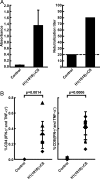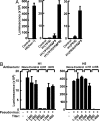Protective immunity to lethal challenge of the 1918 pandemic influenza virus by vaccination
- PMID: 17043214
- PMCID: PMC1613227
- DOI: 10.1073/pnas.0607564103
Protective immunity to lethal challenge of the 1918 pandemic influenza virus by vaccination
Abstract
The remarkable infectivity and virulence of the 1918 influenza virus resulted in an unprecedented pandemic, raising the question of whether it is possible to develop protective immunity to this virus and whether immune evasion may have contributed to its spread. Here, we report that the highly lethal 1918 virus is susceptible to immune protection by a preventive vaccine, and we define its mechanism of action. Immunization with plasmid expression vectors encoding hemagglutinin (HA) elicited potent CD4 and CD8 cellular responses as well as neutralizing antibodies. Antibody specificity and titer were defined by a microneutralization and a pseudotype assay that could assess antibody specificity without the need for high-level biocontainment. This pseudotype inhibition assay can define evolving serotypes of influenza viruses and facilitate the development of immune sera and neutralizing monoclonal antibodies that may help contain pandemic influenza. Notably, mice vaccinated with 1918 HA plasmid DNAs showed complete protection to lethal challenge. T cell depletion had no effect on immunity, but passive transfer of purified IgG from anti-H1(1918) immunized mice provided protective immunity for naïve mice challenged with infectious 1918 virus. Thus, humoral immunity directed at the viral HA can protect against the 1918 pandemic virus.
Conflict of interest statement
The authors declare no conflict of interest.
Figures





References
-
- Stevens J, Blixt O, Glaser L, Taubenberger JK, Palese P, Paulson JC, Wilson IA. J Mol Biol. 2006;355:1143–1155. - PubMed
-
- Taubenberger JK, Reid AH, Lourens RM, Wang R, Jin G, Fanning TG. Nature. 2005;437:889–893. - PubMed
-
- Kobasa D, Takada A, Shinya K, Hatta M, Halfmann P, Theriault S, Suzuki H, Nishimura H, Mitamura K, Sugaya N, et al. Nature. 2004;431:703–707. - PubMed
Publication types
MeSH terms
Substances
Grants and funding
LinkOut - more resources
Full Text Sources
Other Literature Sources
Medical
Research Materials

